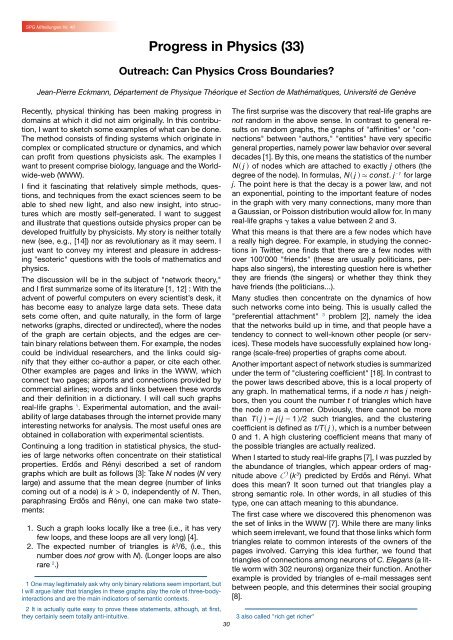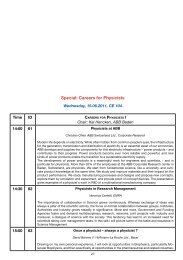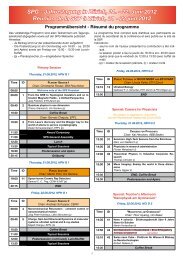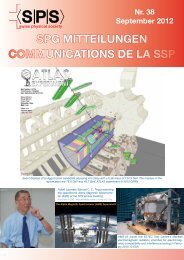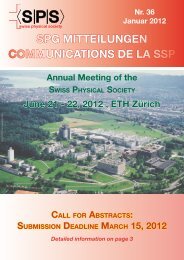spg mitteilungen communications de la ssp - Schweizerische ...
spg mitteilungen communications de la ssp - Schweizerische ...
spg mitteilungen communications de la ssp - Schweizerische ...
Create successful ePaper yourself
Turn your PDF publications into a flip-book with our unique Google optimized e-Paper software.
SPG Mitteilungen Nr. 40<br />
Progress in Physics (33)<br />
Outreach: Can Physics Cross Boundaries?<br />
Jean-Pierre Eckmann, Département <strong>de</strong> Physique Théorique et Section <strong>de</strong> Mathématiques, Université <strong>de</strong> Genève<br />
Recently, physical thinking has been making progress in<br />
domains at which it did not aim originally. In this contribution,<br />
I want to sketch some examples of what can be done.<br />
The method consists of finding systems which originate in<br />
complex or complicated structure or dynamics, and which<br />
can profit from questions physicists ask. The examples I<br />
want to present comprise biology, <strong>la</strong>nguage and the Worldwi<strong>de</strong>-web<br />
(WWW).<br />
I find it fascinating that re<strong>la</strong>tively simple methods, questions,<br />
and techniques from the exact sciences seem to be<br />
able to shed new light, and also new insight, into structures<br />
which are mostly self-generated. I want to suggest<br />
and illustrate that questions outsi<strong>de</strong> physics proper can be<br />
<strong>de</strong>veloped fruitfully by physicists. My story is neither totally<br />
new (see, e.g., [14]) nor as revolutionary as it may seem. I<br />
just want to convey my interest and pleasure in addressing<br />
"esoteric" questions with the tools of mathematics and<br />
physics.<br />
The discussion will be in the subject of "network theory,"<br />
and I first summarize some of its literature [1, 12] : With the<br />
advent of powerful computers on every scientist’s <strong>de</strong>sk, it<br />
has become easy to analyze <strong>la</strong>rge data sets. These data<br />
sets come often, and quite naturally, in the form of <strong>la</strong>rge<br />
networks (graphs, directed or undirected), where the no<strong>de</strong>s<br />
of the graph are certain objects, and the edges are certain<br />
binary re<strong>la</strong>tions between them. For example, the no<strong>de</strong>s<br />
could be individual researchers, and the links could signify<br />
that they either co-author a paper, or cite each other.<br />
Other examples are pages and links in the WWW, which<br />
connect two pages; airports and connections provi<strong>de</strong>d by<br />
commercial airlines; words and links between these words<br />
and their <strong>de</strong>finition in a dictionary. I will call such graphs<br />
real-life graphs 1 . Experimental automation, and the avai<strong>la</strong>bility<br />
of <strong>la</strong>rge databases through the internet provi<strong>de</strong> many<br />
interesting networks for analysis. The most useful ones are<br />
obtained in col<strong>la</strong>boration with experimental scientists.<br />
Continuing a long tradition in statistical physics, the studies<br />
of <strong>la</strong>rge networks often concentrate on their statistical<br />
properties. Erdős and Rényi <strong>de</strong>scribed a set of random<br />
graphs which are built as follows [3]: Take N no<strong>de</strong>s (N very<br />
<strong>la</strong>rge) and assume that the mean <strong>de</strong>gree (number of links<br />
coming out of a no<strong>de</strong>) is k > 0, in<strong>de</strong>pen<strong>de</strong>ntly of N. Then,<br />
paraphrasing Erdős and Rényi, one can make two statements:<br />
1. Such a graph looks locally like a tree (i.e., it has very<br />
few loops, and these loops are all very long) [4].<br />
2. The expected number of triangles is k 3 /6, (i.e., this<br />
number does not grow with N). (Longer loops are also<br />
rare 2 .)<br />
1 One may legitimately ask why only binary re<strong>la</strong>tions seem important, but<br />
I will argue <strong>la</strong>ter that triangles in these graphs p<strong>la</strong>y the role of three-bodyinteractions<br />
and are the main indicators of semantic contexts.<br />
2 It is actually quite easy to prove these statements, although, at first,<br />
they certainly seem totally anti-intuitive.<br />
3 also called "rich get richer"<br />
30<br />
The first surprise was the discovery that real-life graphs are<br />
not random in the above sense. In contrast to general results<br />
on random graphs, the graphs of "affinities" or "connections"<br />
between "authors," "entities" have very specific<br />
general properties, namely power <strong>la</strong>w behavior over several<br />
<strong>de</strong>ca<strong>de</strong>s [1]. By this, one means the statistics of the number<br />
N^ j h of no<strong>de</strong>s which are attached to exactly j others (the<br />
-c<br />
<strong>de</strong>gree of the no<strong>de</strong>). In formu<strong>la</strong>s, N^ j h . const.<br />
j for <strong>la</strong>rge<br />
j. The point here is that the <strong>de</strong>cay is a power <strong>la</strong>w, and not<br />
an exponential, pointing to the important feature of no<strong>de</strong>s<br />
in the graph with very many connections, many more than<br />
a Gaussian, or Poisson distribution would allow for. In many<br />
real-life graphs g takes a value between 2 and 3.<br />
What this means is that there are a few no<strong>de</strong>s which have<br />
a really high <strong>de</strong>gree. For example, in studying the connections<br />
in Twitter, one finds that there are a few no<strong>de</strong>s with<br />
over 100’000 "friends" (these are usually politicians, perhaps<br />
also singers), the interesting question here is whether<br />
they are friends (the singers) or whether they think they<br />
have friends (the politicians...).<br />
Many studies then concentrate on the dynamics of how<br />
such networks come into being. This is usually called the<br />
"preferential attachment" 3 problem [2], namely the i<strong>de</strong>a<br />
that the networks build up in time, and that people have a<br />
ten<strong>de</strong>ncy to connect to well-known other people (or services).<br />
These mo<strong>de</strong>ls have successfully exp<strong>la</strong>ined how longrange<br />
(scale-free) properties of graphs come about.<br />
Another important aspect of network studies is summarized<br />
un<strong>de</strong>r the term of "clustering coefficient" [18]. In contrast to<br />
the power <strong>la</strong>ws <strong>de</strong>scribed above, this is a local property of<br />
any graph. In mathematical terms, if a no<strong>de</strong> n has j neighbors,<br />
then you count the number t of triangles which have<br />
the no<strong>de</strong> n as a corner. Obviously, there cannot be more<br />
than T^<br />
j h = j^j - 1h / 2 such triangles, and the clustering<br />
coefficient is <strong>de</strong>fined as t/<br />
T^ j h, which is a number between<br />
0 and 1. A high clustering coefficient means that many of<br />
the possible triangles are actually realized.<br />
When I started to study real-life graphs [7], I was puzzled by<br />
the abundance of triangles, which appear or<strong>de</strong>rs of magnitu<strong>de</strong><br />
above (k 3 ) predicted by Erdős and Rényi. What<br />
does this mean? It soon turned out that triangles p<strong>la</strong>y a<br />
strong semantic role. In other words, in all studies of this<br />
type, one can attach meaning to this abundance.<br />
The first case where we discovered this phenomenon was<br />
the set of links in the WWW [7]. While there are many links<br />
which seem irrelevant, we found that those links which form<br />
triangles re<strong>la</strong>te to common interests of the owners of the<br />
pages involved. Carrying this i<strong>de</strong>a further, we found that<br />
triangles of connections among neurons of C. Elegans (a little<br />
worm with 302 neurons) organize their function. Another<br />
example is provi<strong>de</strong>d by triangles of e-mail messages sent<br />
between people, and this <strong>de</strong>termines their social grouping<br />
[8].


